Maximising the returns from growing biomass
by Michael Doran, business development manager of Rural Generation Limited
Farmers should not expect to find that simply growing energy crops will
prove very profitable. They must also use such crops to meet needs
besides those for heat and power which people will pay them to fill.
Rural Generation is a small private limited
company formed in 1996 by John Gilliland, the
current President of the Ulster Farmers Union,
to commercialise an R & D project undertaken
by the Department of Agriculture in Northern
Ireland involving gasifying willow chip to produce
heat and power. Mr. Gilliland had been
looking at alternative land uses from the 1990s
and had planted some willow coppice in 1994
in association with the Horticulture and Plant
Breeding Station at Loughgall, Co. Armagh, on
his Brook Hall Estate in Co Derry. Further
plantings have taken place since and we now
have 45 hectares of which 15 hectares are harvested
each year.
Willows may be planted from March to June,
and planting can be by hand or by automatic
planter, which is normal on areas greater than
one acre.
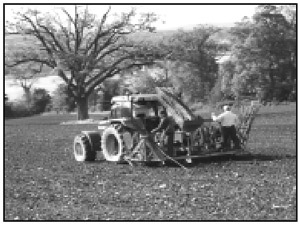 |
| Planting Willows |
The planter shown is capable of planting
four rows at a time. Willows are usually
planted in double rows, with cuttings 70cm
apart in each row, with a space of 1.4m between
double rows. A cutting 20cm long is taken from
a rod approximately 3m long. The cutting is put
into the ground vertically without an established
root system. Cuttings are usually planted
at 14,000 to the hectare.
Willows will grow in most soils, except highly
organic. Ground preparation is important, and
includes ploughing, power harrow and rolling.
Rabbit fencing is critical for the first six months
of growth, until the willows are established. The
only pest that is likely to cause problems at the
early stage is the leatherjacket, which will eat
the cuttings unless treated.
Typically in the first year the willows will grow
to a height of approximately 1.5m. They will
grow as a single stem. It is normal to mix 5 or 6
different clonal types when planting. Willows
are susceptible to attack by rust, which will
affect the leaves. While rust will not actually
kill the plant it will effectively destroy the willows'
ability to transpire through the leaf and
will severely stunt growth. The use of polyclonal
types will completely eradicate damage
from rust.
In the winter at the end of the first year of
growth the willows are cut back to ground level,
usually using a finger bar mower.
When the
plant re-grows in spring of the second year it
will "multi-shoot" and 5 or 6 stems will be
reproduced from the original single stem plant.
 |
| Willows on Brook Hall Estate |
This coppicing is done to increase the yield.
After cut back the willow will usually grow 3-
4m in the first year. It will continue to grow for
another two years after which time it is harvested.
Further harvesting usually takes place every
three years. This has been found to provide the
best yield because if crops are harvested every
one or two years their bulk yield is small while
past year three, the percentage increase in bulk
yield is marginal.
At Brook Hall Estate we use a modified Claas
forage harvester that makes chip. This is fed
directly into trailers and taken back to the farmyard.
Our willow normally yields approximately
30 dry tonnes of chip per hectare per harvest.
As the harvest is only done every three years
this equates to 10 dry tonnes per hectare per
annum. The harvester can cut up to 8 hectares
per day in good conditions. Even though the
harvesting is usually carried out in January or
February the ground tends to be dry as a result
of the willow establishment.
Traditionally willow is harvested by rod. This
can be carried out by using a strimmer, or by a
mechanical rod harvester. The main benefit of
rod harvesting is that is avoids the necessity for
drying the willow before combustion. At harvest
time willow is usually about 55% moisture
content. If chipped, the chips will have to be
dried or the biomass will effectively create a
compost heap, with a considerable loss of combustible material. If rod harvested, the rods can
be stacked at the end of the field, and by early
summer they will have dried naturally to
approximately 35% moisture content without
any degradation of the fuel.
Rod harvesting is labour intensive and is
impractical for large areas. However, for smaller
plots, and where drying facilities are not
available, rod harvesting is far more cost effective.
Figure 6D1 gives an indication of the cost of
planting willow coppice per hectare.

The total
indicative cost is approximately €3,000 per
hectare. This includes for mechanical planting,
cuttings, fencing and weed control which is
important in the first year of growth. Planting
costs in Scandinavia are approximately €2,000
per hectare because their industry has established
a "critical mass" which ensures
economies of scale particularly with regard to
the cost of cuttings and the hire of mechanical
planters. As the industry develops in this country
we expect these establishment costs to fall.
Figure 6D2 shows the typical cost of maintaining
and harvesting the willows per rotation. The
harvesting cost depends on whether it is by
hand or by machine and on the volume i.e. a
large area, in excess of 10 hectares, harvested
by machine is likely to be around €600 per
hectare.
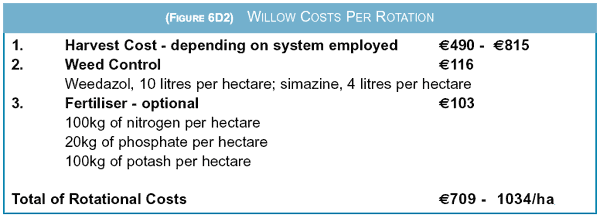
USING WILLOW AS A BIO-FILTER
Rural Generation Limited has developed the
use of willows as a bio-filter to treat dirty water
or effluent. In 1998 an EU research project was
set up a Culmore in Co. Derry to monitor the
effects of disposing of dirty water and sludge
onto willow coppice. Regulations for the disposal
of wastewater and sludge are becoming
stricter and environmentally acceptable options
must be found for dealing with these wastes.
Four hectares of short rotation coppice were
planted in May 1998 adjacent to Culmore Water
Treatment Works. This is a relatively large
treatment plant servicing the equivalent of
120,000 people. A ground water irrigation system
was installed consisting of 28mm diameter
pipes with holes at 8m centres. The flow of
effluent through the pipes is controlled by
pumps and motorised valves.
The site is divided into separate plots, one control
plot receives no irrigation, a second plot
receives irrigation with pure water, a third plot
receives the sludge, a fourth plot receives irrigation
with waste water at 1 times the potential
evapotransperation (PE), a fifth plot at 2 x PE
and a sixth plot 3 x PE The site was harvested
early in 2002 and yields were measured, as well
as chemical and microbiological ground water,
pests, disease and weed problems.
During harvesting the irrigation pipework was
only damaged twice and this was repaired easily.
Figure 6D3 summarises the results. The volumes
of NP & K were recorded as well as the
total volume of effluent, which was only
applied during the growing season.

Figure 6D4 indicates the yields from the various
trial plots. It is interesting to note that the
control plot which received no irrigation has in
fact yielded greater mass than the plots which
received 1 x PE waste water, 2 x PE waste water
and 1 x PE clear water. We do not have an
explanation for this.
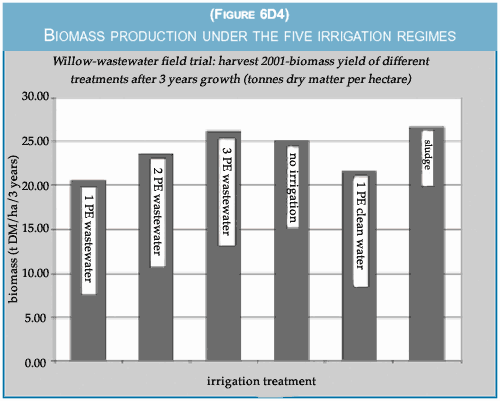 One of the reasons why the site at Culmore was
chosen was because the water table in the
ground is only 60cm below ground level. When
monitoring the capability of the willows to
absorb nutrient we were particularly concerned
that effluent was not flowing through the willows
and entering the ground water. Therefore,
had we selected a site with a water table deep
below the surface we would have been unsure if
it was the willows or the ground filtering that
was absorbing the nutrients. By selecting a site
with a high water table we were able to establish
that no detectable levels of nitrate, phosphate
or heavy metals were entering the ground
water.
One of the reasons why the site at Culmore was
chosen was because the water table in the
ground is only 60cm below ground level. When
monitoring the capability of the willows to
absorb nutrient we were particularly concerned
that effluent was not flowing through the willows
and entering the ground water. Therefore,
had we selected a site with a water table deep
below the surface we would have been unsure if
it was the willows or the ground filtering that
was absorbing the nutrients. By selecting a site
with a high water table we were able to establish
that no detectable levels of nitrate, phosphate
or heavy metals were entering the ground
water.
Generally there was a trend towards greater
biomass yields as the volume of wastewater
irrigated rose. There are practical limits as to
how much effluent can be absorbed by willow
and potassium (P) is normally the limiting factor.
It is also likely that effluent with a
Biological Oxygen Demand (BOD) in excess of
500 can be adequately treated using willow as a
bio-filter.
HEAT FROM BIOMASS
This section is concerned with the combustion
of willow chip and wood chip in solid fuel boilers,
and also with the combustion of waste agricultural
products such as chicken litter and
spent mushroom compost.
Rural Generation Limited has taken on the Irish agency for Farm 2000 boilers. There are several
different boiler types within the range including
Big Bale boilers, High Temperature boilers
and automatic feed Swebo boilers.
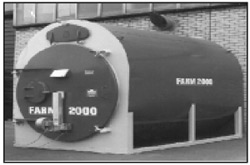 |
| Big Bale, Multi fuel, Farm 2000 Boiler |
Big Bale boilers, as illustrated, were originally designed
to accommodate full size round bales. It is now
more usual to burn waste products such as timber,
cardboard or paper than to burn materials
that have a value such as straw.
The automatic feed Swebo boilers consist of a
full storage hopper, a combustion chamber and
a modified boiler. In automatic feed mode the
wood chips or willow chips within the hopper
are delivered to the round combustion chamber
by a screw auger. The rate of combustion and
the amount of heat produced can be regulated
by the auger speed. Full combustion takes place
within the ceramic pot, and a flame is then fed
into the boiler chamber, where the water is heated.
The automatic feed systems can also be operated
in manual mode, where the fuel is fed directly
into the boiler through the usual door. This
allows the operator to use a range of waste fuels
such as cardboard, paper, logs etc. While it is
labour intensive it can be cost effective if the
fuel has little or no cost. Figure 6D5 shows the
comparative cost of wood chips versus oil. For
example, if wood chips are being purchased at
€73 per ton, and heating oil is costing 34.5
cents per litre then the heating bill for a system
running on wood chips will be 54% of the comparative
bill for an oil fired systems.

It is worth noting that these costs are based on
wood chips with 30% moisture content.
However, the willow chips produced by Rural
Generation typically have moisture content of
approximately 10%. Therefore, the savings will
be greater because the calorific value of timber
rises as the moisture content falls. Taking the
€73/34.5 cents per litre oil scenario, for wood
chips at 10% moisture the comparative cost
would be 34% i.e. heating by wood chip would
be 34% of the cost of heating by oil.
Rural Generation Limited has recently installed
one of these boilers into an alcohol rehabilitation
unit in Co. Donegal. They run the system in
both automatic feed and manual feed mode
depending on the availability of labour.Rural
Generation also supplies willow chip to a community
centre in Derry. Another manufacturer
supplied the boiler in Creggan Community
Centre, but the quality of chip provided by
Rural Generation proved to be a better fuel than
anything else they could obtain.
A gasifer was built under a Non Fossil Fuel
Obligation (NFFO) contract at Brook Hall
Estate in Derry with a capacity of 95kWe and
200kWth. It has been producing heat and power
for the past six years.
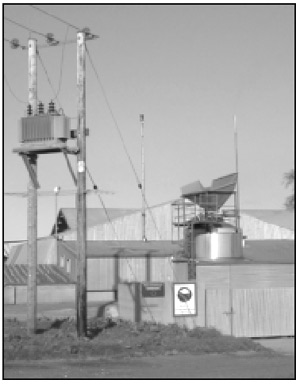 |
| Gasifier and Generator Building with Grid Connection,
Brook Hall Estate |
The gasifier has been
modified continuously as part of a managed
development programme and is now capable of
producing 200 cubic metres of wood gas per
hour. This wood gas is used to drive a diesel
engine that in turn is linked to a generator. The
generator produces electricity, which is exported
to the Northern Ireland grid via the transformer.
The gasifier comprises a 9cubic metre
stainless steel hopper, which holds wood chip
or willow chip. This feeds a down draft gasifier
that is linked to an Iveco diesel engine. The system
runs in batch mode and typically operates
for 12/14 hours per day producing electricity
and thermal energy. The thermal energy (hot
water) is used to dry cereals on the 400-hectare
Brook Hall Farm. The heat is also used in the
winter months to dry willow chip that will subsequently
be used in the gasifer.
The capital cost of the gasifier is approximately
€2,000 per kW. This includes containerised
units, hopper, control system, electricity generating
system, safety mechanisms, heat exchangers
on the engine exhaust and the engine cooling
system and all installation and commissioning.
The cost does not include for structural
modifications to accommodate the CHP unit,
compressed air supply, fuel storage silo or grid
connection costs.
LOOKING AHEAD
I have already discussed the work that Rural
Generation has done with regard to bio-filtration,
heat and power generation from willows
and heat only applications. We are however
continuing to push forwards to find holistic
solutions to other problems.
Northern Ireland produces approximately
200,000 tonnes of spent mushroom compost
every year. This is becoming increasingly difficult
to dispose of, as the traditional route of
land spread becomes less viable due to legislative
changes. Rural Generation has developed a
system for co-combusting spent mushroom
compost with dried willow chip. The heat generated
can then be recycled to heat the mushroom
house.
Spent mushroom compost typically has a 80%
moisture content. Virtually all other attempts to
reduce this moisture content to a level at which
the compost will satisfactorily burn, (usually
about 40%), have required a greater energy
input than is subsequently derived from the
combustion. I.e. you have to expend more energy
to reduce the moisture content than the compost
subsequently produces on combustion.
Rural Generation has found a solution to this
problem.
Rural Generation has also successfully combusted
chicken litter in their boiler systems.
Tests are now going on to ensure that emission
levels, particularly of ammonia, are reduced to
an acceptable level. Rural Generation has also
been involved in trials using "fine" willow chip
as a bedding material in chicken houses. While
this is still at an experimental stage early indications
are that the salicylic acid in the willow
can substantially reduce the amount of ammonia
in the chicken litter. This is always a prime
concern for chicken farmers who are trying to
reduce "hock burn" by keeping levels of ammonia
as low as possible. If our tests are successful
this will open up a new market for willow
chip. The chicken industry in Northern Ireland
currently relies on imported wood shavings for
the bulk of its litter.
The future lies in integrated environmental
solutions and not in energy alone. Rural
Generation believes that while the production
of willow as an energy crop can generate profits
for the farmer of the order of €250 per
hectare, the profitability of the venture is
enhanced significantly when the coppice has
supplemental use.
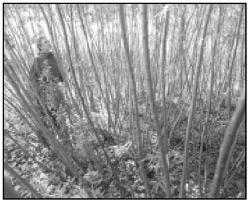 |
| Willows ready for harvest |
If short rotation coppice is
used as a bio-filter for sewage sludge the profit
margins are likely to be increased significantly.
Similarly if willow chip is used as chicken litter
the value of the chip is likely to be greater than
the market value for chip as a fuel which is currently
around €65 per ton.
We believe that farmers and commercial growers
should look at all the options which willows
offer before committing to a course of action.
Traditionally farmers have produced a product.
They deliver the product to the farm gate and by
the time that product has reached the consumer
it will have increased in value or cost by a factor
of around 4. If farmers commit the same sin
when producing willow, by stopping at the first
interface in the supply chain they will prevent
themselves from maximising value from their
product. This is probably the most difficult
aspect of willow cultivation for farmers to
grasp. They are comfortable with production
only scenarios. They need to increase their
involvement in the supply chain to maximise
returns and to add value to what is a relatively
simple product.
|
This is one of almost 50
chapters and articles in the 336-page large format book, Before the Wells
Run Dry. Copies of the book are available for £9.95 from Green Books. |
 |
Continue to part E of Section 5: The case for returning to real live horse power
Sitemap for Before the Wells Run Dry





 One of the reasons why the site at Culmore was
chosen was because the water table in the
ground is only 60cm below ground level. When
monitoring the capability of the willows to
absorb nutrient we were particularly concerned
that effluent was not flowing through the willows
and entering the ground water. Therefore,
had we selected a site with a water table deep
below the surface we would have been unsure if
it was the willows or the ground filtering that
was absorbing the nutrients. By selecting a site
with a high water table we were able to establish
that no detectable levels of nitrate, phosphate
or heavy metals were entering the ground
water.
One of the reasons why the site at Culmore was
chosen was because the water table in the
ground is only 60cm below ground level. When
monitoring the capability of the willows to
absorb nutrient we were particularly concerned
that effluent was not flowing through the willows
and entering the ground water. Therefore,
had we selected a site with a water table deep
below the surface we would have been unsure if
it was the willows or the ground filtering that
was absorbing the nutrients. By selecting a site
with a high water table we were able to establish
that no detectable levels of nitrate, phosphate
or heavy metals were entering the ground
water.




